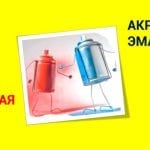Consumers are often faced with a choice: which paint to prefer - acrylic or alkyd? To answer this question, you need to understand the features of these compounds, their advantages and disadvantages.
Alkyd paints
Alkyd paints and varnishes (LKM) can be attributed to an advanced variety of oil formulations. For alkyd paints, the same solidification and film formation mechanism is inherent. Moreover, the film is more durable, although not so elastic. To correct the lack of elasticity, natural oils are added to the alkyd mixtures.
Alkyd coatings include polyhydric alcohols (for example, propane-1,2,3-triol, otherwise called glycerin), as well as orthophthalic acid. The word "alkyd" itself is a construct formed by combining the words "alcohol" (alcohol) and "acid" (acid). Depending on the type of alcohol component, alkyd coatings are divided into pentaphthalic and glyphthalic.
Alkyd paints are one of the most common types of paints and varnishes, and there are many reasons for this:
- Low cost - this is perhaps the main advantage of alkyd compounds. The availability of paint is especially important with a limited budget or the need to paint surfaces with significant surface area.
- Working with alkyd coatings is simple: no special instructions are needed, and all work can be done independently. The composition is diluted with an organic solvent and applied with a brush or roller.
- The coating dries quickly enough, and the initial polymerization occurs after about 60 minutes. Full drying occurs in a few days. The dried surface is ready for use in harsh environments.
- Alkyd coatings are resistant to moisture.
- Coatings are neutral to aggressive chemicals (e.g. household chemicals).
The disadvantages of alkyd compounds:
- Insufficient wear resistance and resistance to mechanical stress. The durability of alkyd coatings leaves much to be desired: usually after a year and a half the surface turns yellow and begins to crack. As a result, the product will have to be painted too often. Sometimes this drawback can be ignored, but in most cases for important surfaces it is better to choose a different type of paint.
- Instability to the effects of ultraviolet radiation, due to which the coating will soon begin to fade and crack. For this reason, alkyd paints are not recommended for facades.
- Alkyd mixtures contain chemical elements that are harmful to human health. In addition, a sharp odor emanates from freshly painted surfaces, which disappears in no less than a day.
- Not a very rich color scheme. This disadvantage is corrected by buying the right color.
- Inadequate fire safety.
Acrylic paints
Polyacrylic polymers act as a base in acrylic compositions. Acrylic paints and varnishes are made on the basis of a polymer, which is also called plexiglass. Special components are added to the composition that improve certain characteristics of the paint, for example, its elasticity, resistance to environmental factors, or drying speed.
Advantages of acrylic compositions:
- Acrylates retain their characteristics even at elevated temperatures. Resistance to high temperatures allows the use of coatings of this group when painting radiators and other surfaces subject to heat. Acrylic paints not only do not crack under the influence of temperature increase, but also do not change the original color.
- Acrylic compounds are characterized by excellent adhesion (the ability to set on foreign surfaces).
- The operation of acrylic coatings can be carried out for at least 8 years in the case of wood and at least 20 years for plastered and metal products.
- Acrylates are resistant to ultraviolet radiation, which means they are excellent for facade work. Acrylic exterior surfaces retain their original appearance for many years.
- Due to the high transparency and the lack of yellowing of the coating, acrylic paints and varnishes are used for painting light woods. Also, the acrylic group is used in conjunction with stains of pastel colors.
- Acrylic coatings are not toxic (unlike alkyd paints), since they do not contain organic solvents. To dissolve the acrylic composition, ordinary water is suitable.
- The paint does not contain hazardous components, as a result of its drying, water evaporates. Therefore, when staining there is no need for protective clothing.
- Due to the absence of toxic solvents in the composition, acrylic coatings are devoid of a pungent odor and are suitable for interior use.
- Acrylic mixtures protect coatings from corrosive processes, and the presence of special additives in them allows even rusted surfaces to be painted.
- Acrylic group is characterized by high fire safety.
- With a small consumption of paint provides a high hiding power.
- Surfaces painted with acrylic paint can breathe. Natural ventilation is extremely useful for maintaining the performance of wood products.
- Acrylic paints dry very quickly - it takes from half an hour to a couple of hours to dry the surface (the specific timing depends on the environmental conditions and the components of the solution). Fast drying is a serious advantage when it comes to tight deadlines for construction work.
- If paint gets into an undesirable place, it can be easily removed without damaging the surface.
The disadvantages of acrylic compositions:
- Relatively high cost.
- Slight solids. This indicator usually does not exceed 30%.
- The coating is gaining strength for quite some time. Final hardening does not occur before 30 days.
Ink compatibility
Acrylic paints are not recommended to be applied to alkyd coatings, since the result of painting in this case cannot be predicted. After painting, the surface can turn out both good quality and bad (if bloating occurs). Alkyd paints and enamels applied to acrylic surfaces will in most cases peel off.
Please note: if acrylic paint is applied to an alkyd coating, its service life is reduced by at least 2 times.
If you still need to apply acrylic paint on the alkyd coating, you need to prepare the surface. First, the product should be thoroughly cleaned with fine-grained sandpaper, and then treated with soil. Preparatory measures will improve the adhesion of materials and reduce the likelihood of peeling paint.
It is not recommended to paint relatively fresh alkyd surfaces with acrylics, especially when it comes to metal. In these cases, dark spots are likely to appear on the surface.
There are alkyd-acrylic compounds used for coloring vehicles. However, their cost is high, and such paints are not used in the construction field.
So, in terms of qualities, the best choice is acrylic paint. However, if the budget is limited or the durability of the coating is not critical, you can opt for alkyd paint.









